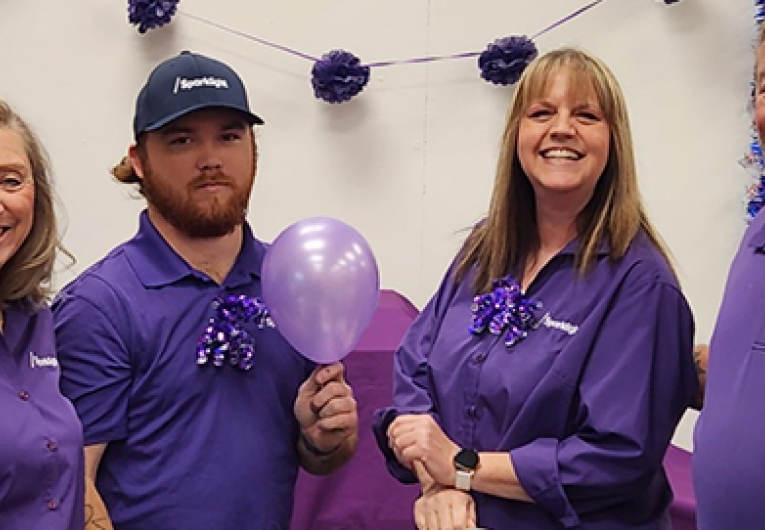
A Breakdown: Different Internet Technology
Your business internet is the backbone of your enterprise. It helps you process financial transactions with clients and vendors. It allows you to connect with customers through online review platforms and social media—it can even help you unwind at the end of a busy workday with your favorite streaming content.
At Sparklight, we believe that understanding the technology that delivers the internet—and all it has to offer—can help your business make informed decisions. Whether you’re expanding, reevaluating your digital needs, or want to know more, this blog has you covered. We break it down for you:
Wired and ReadyThe Big Three
At its core, the internet is a vast and evolving network of wires, cables and connections. While wireless options have emerged over the years, they still rely on this infrastructure that makes it all possible.
Digital Subscriber Line (DSL)
When the internet first rolled out it leveraged the nation’s extensive network of existing copper phone lines to deliver content. All you needed was a phone jack to plug into and a DSL compatible computer or modem, and you were good to go.
DSL internet revolutionized how people and businesses connected, adding an online dimension that set the groundwork for today’s digital commerce. Still in use today—especially in areas where newer cable delivery methods are unavailable—DSL is a tried-and-true option.
Standard Cable
When the world began wiring homes and businesses for cable TV and other services, the Internet gained another delivery method. Standard cable is a high-speed workhorse that’s virtually everywhere today. In fact, according to HighSpeedInternet, nearly 90% of the country is wired and cable ready.
While standard cable also uses copper wire, it combines it with aluminum conductors and other protective materials into coaxial cable that make it durable, reliable and fast. It’s also versatile and can be connected to fiber optic networks, another option we’ll cover soon, to leverage additional speed and bandwidth.
Fiber Optic Cable
Fiber optic cables are made up of thin strands of coated glass fibers that transmit data through pulses of light. While the concept of light transmission had been theorized as early as 1840, large-scale use of fiber optic cable networks didn’t occur until late in the twentieth century.
Extremely fast and robust, fiber can accommodate large load activities, such as video conferencing, large file up- and downloading and more—all without sacrificing speed. As fiber’s footprint continues to expand and augment standard cable, so do the opportunities for consumers and businesses.
Wireless alternatives
Fixed Wireless
An alternative to traditional wireline broadband services is fixed Wireless Internet. Sometimes known as fixed wireless access (FWA), the wireless broadband service that connects fixed locations, such as homes and businesses, through mobile networks. Connectivity is delivered through the transmission of radio signals from base stations, typically place at high elevations on cell towers to either a combined modem & Wi-Fi router or antenna installed on the exterior of a building.
Wireless technologies deliver wireless broadband services on 4G LTE, 5G, and Wi-Fi standards. Despite the name, 5G, this technology has one a common misconception associated with it. The fixed wireless 5G service typically delivers an average of 100–300 Mbps and does not offer 5G of service. Depending on the service, download speeds range anywhere between 3 to 1000 Mbps.
Your Connection to the Internet
Sparklight Business Internet is designed to optimize cable and fiber technologies to best address your everyday challenges. Our footprint is expanding, and so is the technology we leverage to deliver the best solutions possible.
Depending on your location, business size, internet demands and budget we’ll tailor a plan your business can leverage now and also use to grow with down the road. This may include:
• High Speed Data (HSD)
A coaxial cable network delivering high-speed internet that’s shared among multiple customers.
• Passive Optical Network (PON)
A fiber-optic connection with multiple users and high-speed sharing benefits.
• Dedicated Internet Access (DIA)
This solution is suited for larger “enterprise” businesses as it is a dedicated (unshared) high-speed fiber connection specific to one business with speeds that do not fluctuate.
Factors that impact your business internet connection include number of employees or users, types of activities you’ll be conducting online, upload and download file sizes and more. For additional insights into the programs we offer and their technical specifics, check here.
Protecting Your Internet Connection
As you might imagine, wire, cable and fiber delivery networks are susceptible to outages due to natural disasters, storms and other events. Because of this, it’s important to consider contingency plans that allow your business to remain online if your connection is cut off.
Internet Service Protection, a Sparklight innovation, fills the void in the event this happens by diverting your internet activity to nearby wireless networks. When the crisis is over, and your connection is restored, it switches back again, providing uninterrupted service for you and your customers.
Your Choice, Our Mission
Sparklight wants you to be happy with your business internet decision, whether you’re a two-person shop or a 2,000-employee operation. Understanding your options and the technology behind them is just one step in this important mission.
For more information or to discuss your options further, contact us today.
The trends, insights, and solutions you need to grow your business.
By signing up, you’re subscribing to our monthly email newsletter, The
Wire. You may unsubscribe at any time.
Your information stays safe with us. Learn more about our privacy
policy.











![[#MSP_NAME#] Logo](/themes/sparklight_business/images/transition-logos/migration-banner-logo-[#MSP_CD#].png)
